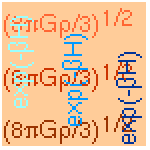
Physics 4xx/8xx
Mechanics of the Cell
PHYS4xx/8xx - Biophysics: Mechanics of the Cell is an introductory course on the mechanical
properties of biological cells and may be taken by senior undergraduates or graduate students interested
in soft condensed matter or biophysics. The support material for the course consists of the 600-page textbook
Mechanics of the Cell
and a set of on-line lecture notes. The textbook is structured so that readers can follow the application
of mechanics to biological cells with minimal reference to the mathematical proofs behind the formalism.
A related set of lectures on statistical mechanics can be found elsewhere in this website, under
PHYS445 - Statistical Mechanics.
The lectures are stored in the form of PDF files and can be read by Adobe
Acrobat Reader (click to download a free copy from Adobe).
Lecture notes to accompany PHYS4xx/8xx
Introduction and review
 Lecture 1 - Cell sizes, shapes and structures
Lecture 1 - Cell sizes, shapes and structures
 Lecture 2 - Molecular building blocks
Lecture 2 - Molecular building blocks
 Lecture 3 - DNA - composition and structure
Lecture 3 - DNA - composition and structure
 Lecture 4 - Soft materials and the Boltzmann factor
Lecture 4 - Soft materials and the Boltzmann factor
 Lecture 5 - Forces and movement in a viscous environment
Lecture 5 - Forces and movement in a viscous environment
Polymers and proteins
 Lecture 1 - Flexible filaments
Lecture 1 - Flexible filaments
 Lecture 2 - Sizes of polymer chains
Lecture 2 - Sizes of polymer chains
 Lecture 3 - Chain elasticity
Lecture 3 - Chain elasticity
 Lecture 4 - Bending resistance of biopolymers
Lecture 4 - Bending resistance of biopolymers
 Lecture 5 - Torsion, twist and writhe
Lecture 5 - Torsion, twist and writhe
 Lecture 6 - Models for protein folding
Lecture 6 - Models for protein folding
Networks in two and three dimensions
 Lecture 1 - Soft networks and their deformation
Lecture 1 - Soft networks and their deformation
 Lecture 2 - Elastic moduli in 2D
Lecture 2 - Elastic moduli in 2D
 Lecture 3 - Properties of two-dimensional networks
Lecture 3 - Properties of two-dimensional networks
 Lecture 4 - Elasticity in three dimensions
Lecture 4 - Elasticity in three dimensions
 Lecture 5 - Three dimensional networks in the cell
Lecture 5 - Three dimensional networks in the cell
 Lecture 6 - Network percolation and failure
Lecture 6 - Network percolation and failure
Membranes
 Lecture 1 - Composition and self-assembly of biomembranes
Lecture 1 - Composition and self-assembly of biomembranes
 Lecture 2 - Bilayer compression and bending resistance
Lecture 2 - Bilayer compression and bending resistance
 Lecture 3 - Mechanical instability and failure
Lecture 3 - Mechanical instability and failure
 Lecture 4 - Membrane bending and persistence length
Lecture 4 - Membrane bending and persistence length
 Lecture 5 - Charged plate in an electrolyte
Lecture 5 - Charged plate in an electrolyte
 Lecture 6 - van der Waals and electrostatic interactions
Lecture 6 - van der Waals and electrostatic interactions
 Lecture 7 - The action potential in nerves
Lecture 7 - The action potential in nerves
 Lecture 8 - Model for signal propagation
Lecture 8 - Model for signal propagation
The Whole Cell
 Lecture 1 - Energetics of the bilayer
Lecture 1 - Energetics of the bilayer
 Lecture 2 - Vesicles and the human erythrocyte
Lecture 2 - Vesicles and the human erythrocyte
 Lecture 3 - Movement in the cell
Lecture 3 - Movement in the cell
 Lecture 4 - Forces and torques
Lecture 4 - Forces and torques
 Lecture 5 - Polymerization of actin and tubulin
Lecture 5 - Polymerization of actin and tubulin
 Lecture 6 - Molecular motors
Lecture 6 - Molecular motors
Control and organization
 Lecture 1 - Cell division
Lecture 1 - Cell division
 Lecture 2 - Rate equations: switches and stability
Lecture 2 - Rate equations: switches and stability
 Lecture 3 - Replicating the blueprint
Lecture 3 - Replicating the blueprint
 Lecture 4 - Molecular basis of regulation
Lecture 4 - Molecular basis of regulation
Supplementary notes
 Supplement 1 - Chemical bonding
Supplement 1 - Chemical bonding



